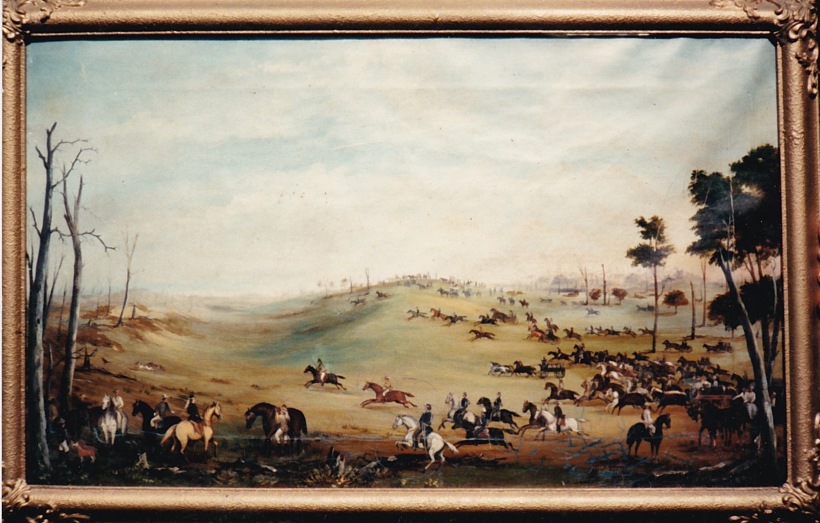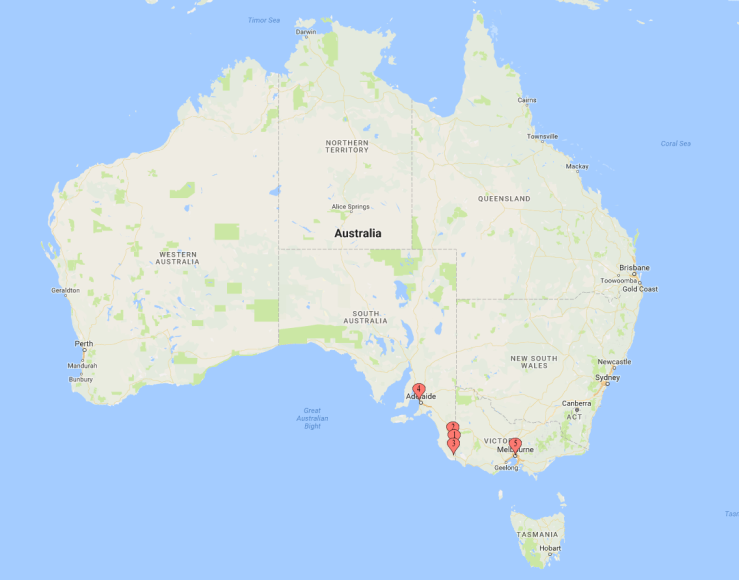William Robbie from Aberdeen was my favourite ancestor as a child. According to my grandmother he married Elizabeth Steven who disgraced her very good family by running away with an artist, marrying secretly and coming to Australia with him.
A few years ago we visited Mt Gambier and saw one of William Robbie’s painting in the house of Robert and Ethel Smith in Naracoorte. The painting is called “The First Hunt”, and was painted at Comaum near Naracoorte around 1867.

The couple told me he had painted the living room ceiling of Hynam House, on a property belonging to their family. One hundred years to the day an earthquake cracked the ceiling. Repairs necessitated the removal of the painting but they have still kept William Robbie’s signature exposed in one corner.
It all sounds quite plausible, but was William the impoverished artist who spirited away the wealthy Elizabeth from her privileged life?
A Robbie Family History, written by Roslyn Brown of Bundoora, Victoria, shows that William and Elizabeth were married in 1859 at St Nicholas Church, Aberdeen. He was a Seaman in the Merchant Service and she was a Domestic Servant. His father, George, was a Wood Sawyer while Elizabeth’s father’s occupation is listed as a House Carpenter. There goes the story of the maiden seduced from her wealthy family by the dashing artist.
Thus, in 1865 William aged 28 and Elizabeth aged 33 departed Liverpool with three children aged 5, 3 and less than one year on the ship “Western Ocean”.

After arriving in Melbourne they travelled to Penola in South Australia where they had twin boys, two more sons and then my great grandmother Christina. Between 1876 and 1880 the family lived in Penola and operated a shop in Market Square. In 1877 another child, Williamena was born. William expanded from the small town of Penola to the larger Mount Gambier where he opened a shop, advertising his services as a house, sign and coach painter, paper-hanger, gilder, grainer and scenic artist. Opening a second shop in Mount Gambier he must have closed the Penola shop but still kept the house, which he rented out.

For some reason William decided to sell the contents of both shops and the businesses. He sold the property in Penola in 1882 and moved to Glanville in Adelaide where he commenced business as a painter. I assumed this was as a house painter until I found the following articles in the Port Adelaide News, 17 July 1883 and the Port Adelaide News and LeFevre’s Peninsula Advertiser, 22 Aug 1884, respectively.
Despite the glowing accolades in these articles he was declared insolvent in 1884. The girls Christina and Williamena enrolled at the local Le Fevre Primary School but were only there seven months when William took the whole family back to Mount Gambier.

William may have been defeated but he did not stay down for long. On the 17th November, 1885 he appears again in the local Mt Gambier newspaper with reference to the “Olde English Fayre” held at the Institute Hall in aid of the Holy Church.
“The Fayre will comprise every description of Old English Sports, organ and piano recitals, the trial scene from The Merchant of Venice, amongst other forms of entertainment… together with the OLD ENGLISH STREET, designed and executed by Mr William Robbie where goods of every description will be offered for sale.
William really put a tremendous amount of effort into his street of “Merry Englande” as the newspaper article of 20 Nov 1865 states:
The period was the 16th century and the buildings were all fashioned after the antique style of architecture in vogue in that period…the houses were designed to represent brick buildings touched with plaster and the ingenuity and special ability of the artist were specially noticeable in his attention to details. The artist it should be mentioned was Mr W Robbie of Mt Gambier, whose work had obviously been a source of pleasure and to whom no higher praise can be awarded than that he acquitted himself most creditably of a difficult task.
in 1886 William lived in Mt Gambier and was listed as a painter. He is reported in the newspaper as falling off his horse when colliding with a buggy one Sunday evening. Dazed and shaken he was attended by the chemist who advised a few day’s rest.
The South Eastern Star reported on the play, “The Lady of the Lake” performed on four consecutive nights at The People’s Hall in September 1886. It was directed by William Robbie and he also played the lead character, “Fitzjames”. The newspaper reports diplomatically that it was no easy play for amateurs but as far as the scenery was concerned it was a great success. There were eight scenes representing Lake Katrine, mountain passes, rocky dells and Loch Vennachar…where Roderich Dhu is slain by Fitzjames in mortal combat.
A newspaper review from around that time gives us an idea of the sort of man he was.
The concert in aid of the (Penola) institute took place on Monday evening last. The hall has lately been painted and the scenery redecorated by Mr Robbie, and that gentleman, as is usual with him on occasions of this kind, offered his services in getting up an entertainment to assist the Committee in defraying the expense of the improvements.
After describing the lack of publicity, the haste in which the event was organised, the cold, wet and dark evening and the moderate attendance at the concert, the author, known as “Our Fat Contributor” wrote:
Mr Robbie as the bold outlaw, arrayed in the garb of Old Gaul, with kilt and sporran and eagle feathers, gave a recitation in capital style, and looked the character to perfection, so much so, indeed, that timid individuals might have taken him for the veritable Roderick Dhu himself.
In 1889 money must have been scarce as Elizabeth was advertising as a seamstress. William was still trying to sell his paintings and came up with the idea of an Art Union.
The Border Watch of 24 August 1889 has the following advertisement:
Art Union of Robbie’s Works of Art, consisting of 51 oil paintings of European and Australian scenery. Beautifully mounted in massive gilded frames, valued at 250 pounds…pictures now on view at the Art Gallery Institute. Drawing to take place in the Institute Hall on January 8th 1890. Tickets 2/6 each may be obtained from W Robbie & Son.
On the 7 Feb 1890 it was announced that Mr Eager, an employee on the railway, had won first prize. Mr C Smith of Mt Gambier was second. The fifty winning numbers were listed in the in the newspaper.
Maybe life was looking up for the hapless artist William and his long suffering wife, Elizabeth. Find out more in the next post – P is for Panorama.


What an interesting ancestor and a bonus having seen one of his paintings. DId you inherit his artistic flair?
LikeLiked by 1 person
Love this story! You bring your ancestors to vivid life.
LikeLiked by 1 person
I’m afraid I have no artistic flair although I love looking at other people’s work.
LikeLike
Don’t discount that family story, Linda. It could be – sort of – true. Many of those stories do have some basis in fact. The dates suggest they could be the same person, even though he had 3 children by the time they sailed to Australia. The time between the marriage & the emigration could have been conflated in the story. Many people like to believe they have at least one wealthy ancestor. 🙂
LikeLiked by 1 person
Interesting story both the family story and the researched story.
LikeLiked by 1 person
The more I read about Robbie the more I think he would have really enjoyed working in something like the film industry in sets/construction.
LikeLiked by 1 person
It is sad he put so much effort into everything and to end up the way he did. Maybe as you said he lived in the wrong time.
LikeLiked by 1 person
Another great story. I was hoping to get through all of these tonight but I’m still going. My grandfather’s brother lives in Narracoorte and when we visited him a few years ago, he entertained me by throwing snails from his garden onto the highway for the trucks to run over. He must’ve been close to 90 and he’s still alive. We also visited Mt Gambier and the Bllue Lake. However, what I really loved was this sink hole which had been turned into a garden and at night it was all lit up and they put fruit out to attract the possums. It was magical and fairy-like. Thanks to Google, I can tell you that it was the Umpherston Sinkhole. https://www.mountgambierpoint.com.au/attractions/umpherston-sinkhole/
Best wishes,
Rowena
LikeLiked by 1 person